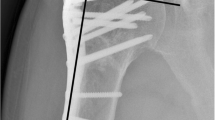Abstract
Purpose
Three part and four-part fractures of the proximal humerus offer challenges in reduction and plate fixation, with considerable debate about use of Deltoid splitting (DS) and Delto-pectoral (DP) approaches, especially when they involving the greater tuberosity. We prospectively compared the results using DS approach and DP approach in these cases, with special focus on functional outcomes, complications, and ease of tuberosity reduction.
Materials and methods
84 patients with three- and four-part proximal humerus fracture were alternately allocated the DP approach or DS approach for proximal humerus locking plate fixation. The outcome analysis was done by evaluating relative Constant score and ease of surgical reduction of greater tuberosity; radiological malunion was evaluated using Beredjiklian classification and complications were noted.
Results
At mean follow-up of 23 months (19–48 months), the mean ‘relative Constant score was 74.27 ± 8.19 in the DP group and 73.26 ± 8.02 in the DS group and the difference was statistically insignificant (p = 0.988). There was no significant difference with respect to shoulder ROM, abductor strength, radiological malunion or complications. However, the mean surgical time was significantly less (p value = 0.042) in DS group (65 ± 5 min) in comparison to DP group (92 ± 4.3 min); significantly less difficulties were documented by the surgeon in reducing the greater tuberosity in DS group(p value = 0.02).
Conclusion
Although surgical time was reduced and greater tuberosity reduction was easier in DS group, the other outcomes were similar; either surgical approach can be used based, and can be based on the experience and comfort level of the surgeon.






Similar content being viewed by others
Data availability
Data available in excel form without any details of patient’s identity.
References
Roux A, Decroocq L, El Batti S, Bonnevialle N, Moineau G, Trojani C, et al. Epidemiology of proximal humerus fractures managed in a trauma center. Orthop Traumatol Surg Res. 2012;98:715–9.
Robinson CM, Amin AK, Godley KC, Murray IR, White TO. Modern perspectives of open reduction and plate fixation of proximal humerus fractures. J Orthop Trauma. 2011;25:618–29.
Demirhan M, Kilicoglu O, Altinel L, et al. Prognostic factors in prosthetic replacement for acute proximal humerus fractures. J Orthop Trauma. 2003;17:181–8.
Aksu N, Aslan O, Kara AN, et al. Simultaneous repair of chronic full-thickness rotator cuff tears during fixation of proximal humerus fractures and clinical results. Acta OrthopTraumatol Turc. 2010;44:173–9.
Hepp P, Theopold J, Voigt C, Engel T, Josten C, Lill H. The surgical approach for locking plate osteosynthesis of displaced proximal humeral fractures influences the functional outcome. J Shoulder Elbow Surg. 2008;17:21–8.
Roderer G, Erhardt J, Kuster M, Vegt P, Bahrs C, Kinzl L, Gebhard F. Second generation locked plating of proximal humerus fractures—a prospective multicentre observational study. Int Orthop. 2011;35:425–32.
Wu CH, Ma CH, Yeh JJH, Yen CY. Locked plating for proximal humeral fractures: differences between the deltopectoral and deltoid-splitting approaches. J Trauma. 2011;71:1364–70.
Berkes MB, Little MT, Lorich DG. Open reduction internal fixation of proximal humerus fractures. Curr Rev Musculoskelet Med. 2013;6:47–56.
Buecking B, Mohr J, Bockmann B, Zettl R, Ruchholtz S. Deltoid-split or deltopectoral approaches for the treatment of displaced proximal humeral fractures? Clin Orthop Relat Res. 2014;472:1576–85.
Neer CS II. Displaced proximal humeral fractures. I. Classification and evaluation. J Bone Jt Surg Am. 1970;52:1077–89.
Carofino BC, Leopold SS. Classifications in brief: the Neer classification for proximal humerus fractures. Clin Orthop Relat research. 2013;471:39–43.
Beredjiklian PK, Iannotti JP, Norris TR, Williams GR. Operative treatment of malunion of a fracture of the proximal aspect of the humerus. J Bone Jt Surg Am. 1998;80:1484–97.
Constant CR, Gerber C, Emery RJH. A review of the Constant score: modifications and guidelines for its use. J Shoulder Elbow Surg. 2008;17:355–61.
Brunner F, Sommer C, Bahrs C, et al. Open reduction and internal fixation of proximal humerus fractures using a proximal humeral locked plate: a prospective multicenter analysis. J Orthop Trauma. 2009;23:163–72.
Gallo RA, Zeiders GJ, Altman GT. Two-incision technique for treatment of complex proximal humerus fractures. J Orthop Trauma. 2005;19:734–40.
Gerber C, Schneeberger AG, Vinh TS. The arterial vascularization of the humeral head: an anatomical study. J Bone Jt Surg Am. 1990;72:1486–94.
Robinson CM, Khan L, Akhtar A, Whittaker R. The extended deltoid-splitting approach to the proximal humerus. J Orthop Trauma. 2007;21:657–62.
Gardner MJ, Boraiah S, Helfet DL, Lorich DG. The anterolateral acromial approach for fractures of the proximal humerus. J Orthop Trauma. 2008;22:132–7.
Liu K, Liu PC, Liu R, Wu X. Advantage of minimally invasive lateral approach relative to conventional deltopectoral approach for treatment of proximal humerus fractures. Med Sci Monit. 2015;21:496–504.
Iyengar JJ, Ho J, Feeley BT. Evaluation and management of proximal humerus fractures. Phys Sportsmed. 2011;39:52–61.
Xie L, Zhang Y, Chen C, Zheng W, Chen H, Cai L. Deltoid-split approach versus deltopectoral approach for proximal humerus fractures: a systematic review and meta-analysis. Orthop Traumatol Surg Res. 2019;105:307–16.
Gupta AK, Harris JD, Erickson BJ, Abrams GD, Bruce B, McCormick F, Nicholson GP, Romeo AA. Surgical management of complex proximal humerus fractures—a systematic review of 92 studies including 4500 patients. J Orthop Trauma. 2015;29:54–9.
Funding
None of the author have received any funding for the study.
Author information
Authors and Affiliations
Corresponding author
Ethics declarations
Conflict of interest
None of the author have any conflict of interest to disclose.
Ethical approval
Approval obtained from department review board.
Consent to participate
Informed written consent obtained from all the participants.
Rights and permissions
About this article
Cite this article
Bhayana, H., Chouhan, D.K., Aggarwal, S. et al. Outcomes of plate osteosynthesis for displaced 3-part and 4-part proximal humerus fractures with deltopectoral vs. deltoid split approach. Eur J Trauma Emerg Surg 48, 4559–4567 (2022). https://doi.org/10.1007/s00068-021-01761-6
Received:
Accepted:
Published:
Issue Date:
DOI: https://doi.org/10.1007/s00068-021-01761-6




